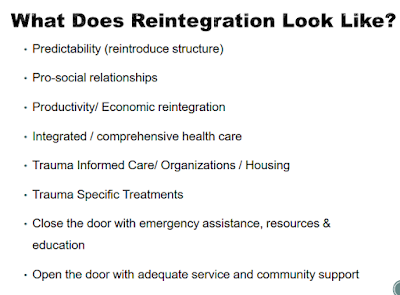Revised: January 2019
By Sarah Owens and Michael Livingston
 |
| courtesy Abode Services |
You might be wondering what it is about this housing program that makes it so ambitious? For sure, the goal of 100 in one year is ambitious, especially in this housing market. But beyond the numbers is the program design.
As long as a family or individual is capable of making that showing of "readiness", the "Housing Ready" model makes a certain amount of sense. It ceases to be valid, however, when applied to more vulnerable populations, like the chronically homeless and the severely mentally ill, who mostly will fail, and fail repeatedly, to meet all the preconditions that constitute "housing readiness." So, the thinking is, why not just skip those steps?
 |
| Barracks-style transitional housing |
 |
| Apartments as transitional hsg for families |
In designing HRAP, Salem Housing Authority staff have had to get creative, do research, confer with to potential partners, hammer out agreements, make and remake lots of lists and develop project and contingency plans. It's one thing to house 30-40 people who happen to come your way over the course of a year's outreach (as SHA staff have quietly been doing). It's entirely another to commit to running a full-blown program with a hefty budget and performance expectations that depend on the support of other non-profits and the business-sector.
 |
| Pamala Garrick addresses July EHN Mtg at UGM |
Who is chosen? The most vulnerable as indicated by their VI-SPDAT and VAT scores. This necessarily means that vulnerable individuals who've not sought services or been assessed will be not be selected. It's therefore vital to the success of the program that highly vulnerable persons seek or be referred for assessment.
Why HRAP? Cost. It's far less costly to maintain someone who is ill or disabled in housing, than it is to maintain him or her on the street. It's also more humane.
How does it work? By integrating three components: housing, case management, and service coordination in service to the overarching goal of housing stability. They will be assisted in developing a housing stability plan. If they have income, they will also have a representative/payee. They will also be offered information on achieving self-sufficiency and how to be a good tenant. They will be assisted in applying for any benefits to which they may be entitled, including treatment for any medical or other conditions for which they wish to have treatment. Their providers will coordinate services, rather than require the client to do so, including any needed assistance with the activities of daily living. They will be assisted in developing their "natural supports."
 |
| Reintegration slides courtesy Stephen Goins |
What is required for success? Housing case management, outreach, intake and orientation, an integrated health service plan (IHSP), a crisis plan, a housing search, landlord engagement, lease compliance and service coordination.
Questions?
"How long to place someone, beginning to end?" There is already a wait list of assessed individuals, prioritized by VI-SPDAT score, from which referrals are being made to the program. Outreach, intake and orientation takes several days. The housing search is the biggest variable at present, because of the tight market. The program contemplates that, following a period of stability, and hopefully within 12 months, participants will graduate to a Housing Choice Voucher (HCV) (requires clients to pay up to 30% of income for housing).
"Could you put three homeless persons in a three bedroom home?" Yes, within HRAP, but not with the HCV. The goal is to stabilize participants in one setting, i.e., avoid moving them. There's also the fact that moving requires another first and last month's rent.
"Thanks for this program, and for a great presentation. It made a pretty complicated program understandable. More of this."
"Have you identified the first 100?" Yes, but the list will keep changing as people are referred and placed in housing and as new people are assessed. Each set of referrals will be made from the most recent list.
"Does a person know if they've been 'SPDATed'?" Probably, but you can always call The ARCHES Project and ask if a client is on the wait list. ARCHES is currently doing 10 to 15 assessments per month.
"What about case management?" All clients will have housing case management at SHA. They will also have case management through any care/treatment service(s) they might receive.
Then, time ran out, though the audience had a lot more questions.
 |
| Stephen Goins on Recovering from Homelessness |
Union Gospel Mission staff shared program information at the meeting as well. They talked about their guest services and New Life Fellowship program. The audience, being sated with lunch and the first presentation, were not as responsive, but not because there was plenty worth talking about.
Hopefully, staff from other agencies/programs will be encouraged by these presentations to share details about their work. If any progress is to be made in this community, providers as well as the wider community have to know what others are trying to do and what kind of outcomes they're getting. Because it's not enough anymore just to say you care, and to ask others to care. We have to work together to give people the help they need, not the help we want to give them; to assist the most vulnerable first, and do so in a way that is maximally likely to benefit them. This approach will challenge some people's beliefs, but research has shown that those beliefs are not based in reality, and therefore need to challenged. We need to acknowledge that many (though not all) of the twists and turns in "reality" illustrated above are a function of systems designed deliberately to result in failure, and we need to abandon those systems. To learn more about reintegration after homelessness, please check out this post.

No comments:
Post a Comment